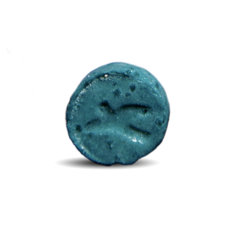Ecstasy (“X”) Drug Effects Information
What is Ecstasy?

MDMA or ecstasy is a Schedule I synthetic, psychoactive drug possessing stimulant and hallucinogenic properties. MDMA possesses chemical variations of the stimulant amphetamine or methamphetamine and a hallucinogen, most often mescaline.
Commonly referred to as Ecstasy or XTC, MDMA was first synthesized in 1912 by a German company possibly to be used as an appetite suppressant. Chemically, it is an analogue of MDA, a drug that was popular in the 1960s. In the late 1970s, MDMA was used to facilitate psychotherapy by a small group of therapists in the United States. Illicit use of the drug did not become popular until the late 1980s and early 1990s. MDMA is frequently used in combination with other drugs. However, it is rarely consumed with alcohol, as alcohol is believed to diminish its effects. It is most often distributed at late-night parties called “raves,” nightclubs, and rock concerts. As the rave and club scene expands to metropolitan and suburban areas across the country, MDMA use and distribution are increasing as well.
How is Ecstasy Used?
MDMA is most often available in tablet form and is usually ingested orally. It is also available as a powder and is sometimes snorted and occasionally smoked, but rarely injected. Its effects last approximately four to six hours. Users of the drug say that it produces profoundly positive feelings, empathy for others, elimination of anxiety, and extreme relaxation. MDMA is also said to suppress the need to eat, drink, or sleep, enabling users to endure two- to three-day parties. Consequently, MDMA use sometimes results in severe dehydration or exhaustion.
What are the Short-term Effects of Ecstasy Abuse?
While it is not as addictive as heroin or cocaine, MDMA can cause other adverse effects including nausea, hallucinations, chills, sweating, increases in body temperature, tremors, involuntary teeth clenching, muscle cramping, and blurred vision. MDMA users also report after-effects of anxiety, paranoia, and depression.
Short-term effects of ecstasy abuse:
- nausea
- hallucinations
- chills and sweating
- increased body temp
- tremors
- muscle cramping
- blurred vision
An MDMA overdose is characterized by high blood pressure, faintness, panic attacks, and, in more severe cases, loss of consciousness, seizures, and a drastic rise in body temperature. MDMA overdoses can be fatal, as they may result in heart failure or extreme heat stroke.
The effects start after about 20 minutes and can last for hours. There is a ‘rush’ feeling followed by a feeling of calm and a sense of well being to those around, often with a heightened perception of color and sound. Some people actually feel sick and experience a stiffening up of arms, legs and particularly the jaw along with sensations of thirst, sleeplessness, depression, and paranoia. Gives a feeling of energy. Some mild hallucinogenic effects.
Many problems users encounter with Ecstasy are similar to those found with the use of amphetamines and cocaine. They include increases in heart rate and blood pressure, nausea, blurred vision, faintness, chills, sweating, and such psychological problems as confusion, depression, sleep problems, craving, severe anxiety, paranoia, and psychotic episodes. Ecstasy’s chemical cousin, MDA, destroys cells that produce serotonin in the brain. These cells play a direct roll in regulating aggression, mood, sexual activity, sleep, and sensitivity to pain. Methamphetamine, also similar to Ecstasy, damages brain cells that produce dopamine. Scientists have now shown that Ecstacy not only makes the brain’s nerve branches and endings degenerate, but also makes them “regrow”, but abnormally—failing to reconnect with some brain areas and connecting elsewhere with the wrong areas. These reconnections may be permanent, resulting in cognitive impairments, changes in emotion, learning, memory, or hormone-like chemical abnormalities.
What are the Long-term Effects of Ecstasy Abuse?
The effects of long-term MDMA use are just beginning to undergo scientific analysis. In 1998, the National Institute of Mental Health conducted a study of a small group of habitual MDMA users who were abstaining from use. The study revealed that the abstinent users suffered damage to the neurons in the brain that transmit serotonin, an important biochemical involved in a variety of critical functions including learning, sleep, and integration of emotion. The results of the study indicate that recreational MDMA users may be at risk of developing permanent brain damage that may manifest itself in depression, anxiety, memory loss, and other neuropsychotic disorders.

MDMA stimulates the release of the neurotransmitter serotonin from brain neurons, producing a high that lasts from several minutes to an hour. The drug’s rewarding effects vary with the individual taking it, the dose and purity, and the environment in which it is taken. MDMA can produce stimulant effects such as an enhanced sense of pleasure and self-confidence and increased energy. Its psychedelic effects include feelings of peacefulness, acceptance, and empathy. Users claim they experience feelings of closeness with others and a desire to touch them. Because MDMA engenders feelings of closeness and trust and has a short duration of action, some clinicians claim that the drug is potentially valuable as a psychotherapeutic agent. However, MDMA is classified by Federal regulators as a drug with no accepted medical use.
Where Does Ecstasy Come From?
Clandestine laboratories operating throughout Western Europe, primarily the Netherlands and Belgium, manufacture significant quantities of the drug in tablet, capsule, or powder form. Although the vast majority of MDMA consumed domestically is produced in Europe, a limited number of MDMA labs operate in the United States.
In addition, in recent years, Israeli organized crime syndicates, some composed of Russian émigrés associated with Russian organized crime syndicates, have forged relationships with Western European traffickers and gained control over a significant share of the European market. The Israeli syndicates are currently the primary source to U.S. distribution groups.
Overseas MDMA trafficking organizations smuggle the drug in shipments of 10,000 or more tablets via express mail services, couriers aboard commercial airline flights, or, more recently, through air freight shipments from several major European cities to cities in the United States. The drug is sold in bulk quantity at the mid-wholesale level in the United States for approximately eight dollars per dosage unit. The retail price of MDMA sold in clubs in the United States remains steady at twenty to thirty dollars per dosage unit.

MDMA traffickers consistently use brand names and logos as marketing tools and to distinguish their product from that of competitors. The logos are produced to coincide with holidays or special events. Among the more popular logos are butterflies, lightning bolts, and four-leaf clovers.
See Also:
 ®
®